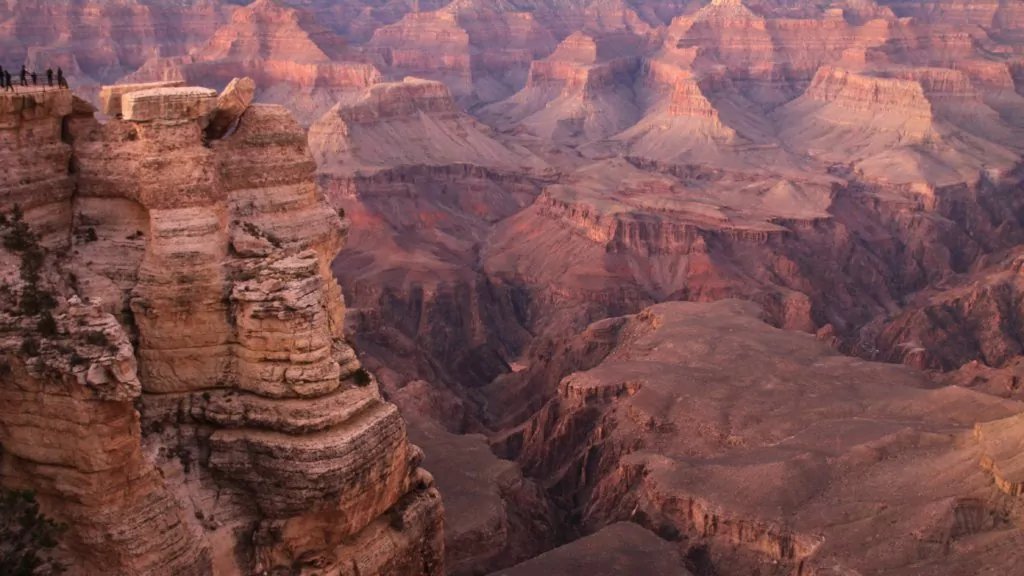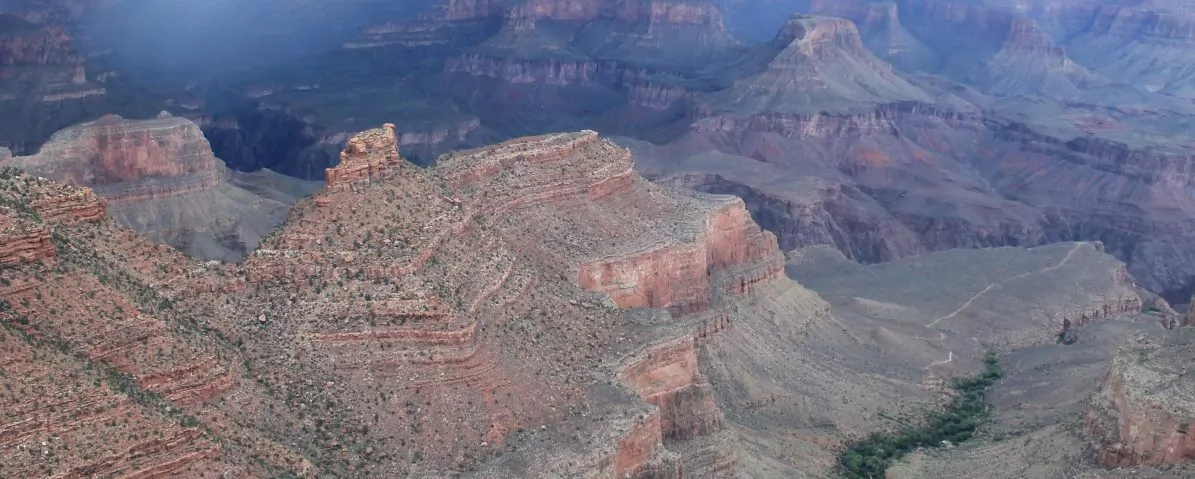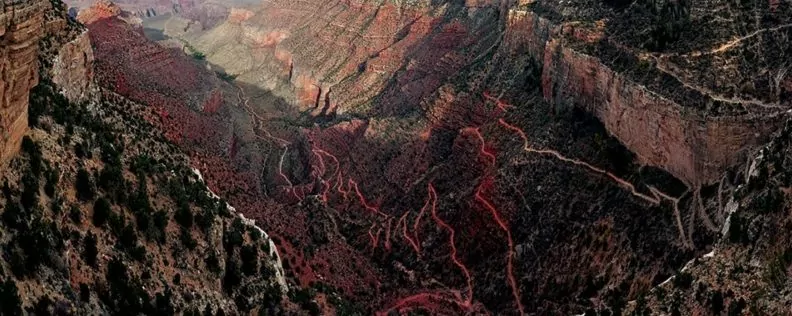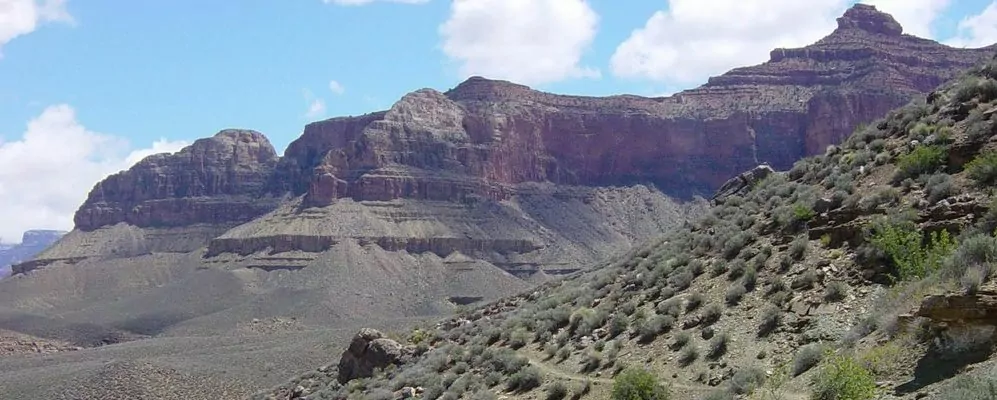
Bright Angel Trail
The best part about the Grand Canyon is that it can be as menacing or as simple as you want it to be. Bright Angel Trail is accessible to all levels of experience, and can also lead to other amazing trails. Any plunge into the canyon is going to be steep, but the Bright Angel is going to have the most reduced grade of any other trail. Regularly patrolled by Park Rangers, it is well-maintained and has multiple water stations and bathrooms along the way. It is a great trail for those visiting the park for the first time. The trail follows the Bright Angel Fault, so hikers are surrounded by massive walls for the first few miles until the canyon opens up in front of you. Bright Angel Trail provides access to the Colorado River at Phantom Ranch, and is commonly used on rim-to-river and rim-to-rim treks.
Explore Grand Canyon with Expert Guides
Getting to the Bright Angel Trailhead
The Bright Angel Trailhead is located in the Village, just west of Bright Angel Lodge. Visitors can park their cars at Maswik Lodge or the backcountry office for easy access. The National Park Service also offers a free shuttle bus that drops off right in front of the trailhead.
History of the Bright Angel Trail
Native Americans used routes through the Bright Angel Fault to reach the Colorado River. Until the 1880s, the Havasupai tribe lived at Havasupai Garden, as it is known today, about 4.5 miles down the Bright Angel Trail. Once the tribe was moved out of the area, Ralph Cameron built the trail as we know it. He held mining claims that gave him access to the entire area, and when he realized the real money was made in the tourism industry, he built a camp for tourists at Havasupai Garden. Cameron charged a one dollar toll for visitors to use his Bright Angel Trail. The Grand Canyon’s famous photographer brothers, the Kolbs, began their life in the canyon by working as his toll collectors. The brothers would also photograph visitors riding mules on the Bright Angel Trail, and since the only water available was down at Havasupai Garden, they would run the 4.5 miles to the stream there, develop their film, and run 4.5 miles back up to the rim, all before the visitors returned on mule.
Coconino County took over the trail in 1912, when Ralph Cameron’s right to operate the trail as a toll road expired. And when Grand Canyon became a National Park in 1919, NPS began to manage the lands around the trail, but the trail still belonged to the County. This led to ongoing battles of control over the trail, and it wasn’t until 1928 that the Park Service took over management of the trail. NPS finished the black bridge across the river around this same time, and enlisted the Civilian Conservation Corps to build the Colorado River Trail, linking the Bright Angel Trail with the South Kaibab Trail.

3 Best Day Hikes on the Bright Angel Trail
The Bright Angel Trail is the one of the best trails for day hiking in the Grand Canyon. With water access and bathrooms along the way, this makes it one of the park’s premier trails for day hikes. If you want to get down into the canyon and it’s your first time at the park, this is the best trail for you.
Below are the primary options for day hiking the Bright Angel Trail:
| Destination | Miles | Elev | Difficulty | Style | |
| Three-Mile Resthouse | 6 mi | 2112 ft | Moderate | Out and Back | |
| Plateau Point | 12.2 mi | 3120 ft | Moderate | Out and Back | |
| Rim-to-River-to-Rim | 17 mi | 4380 ft | Strenuous | Thru-hike |
1. Three-Mile Resthouse
This hike is very straightforward, and perfect for all ages and abilities. Begin at the Bright Angel Trailhead in Grand Canyon Village. The trail will take you on a series of switchbacks. For most of the hike you will be in the back of the Bright Angel Fault, surrounded closely by the canyon walls. It’s a great way to grasp how thick the layers are and how big the canyon is. After 1.5 miles you will reach Mile-and-a-Half Resthouse, which has a bathroom and water station. This is another good place to turn around if you start to feel the effects of the altitude. But if you continue further down the trail, you will keep progressing down the slight grade.
Bright Angel Trail is one of the most trafficked trails in the park, and you will definitely notice the crowds. Remember that uphill hikers have the right of way since they are doing the hard part, and to stay on the right side of the trail. At 3 miles down, you will reach the Three-Mile Resthouse. Here is another set of bathrooms and water station. Make sure you fill up you water resevoirs before heading back up toward the South Rim.
2. Plateau Point
Start at the Bright Angel Trailhead and snake your way down the many, many switchbacks. You will pass Mile-and-a-Half Resthouse, and Three-Mile Resthouse and continue on to Havasupai Garden. A beautiful oasis nestled in the crease of the canyon wall, Havasupai Garden is 4.5 miles down the Bright Angel Trail. From here you will veer west, following signs for Plateau Point. The point is another 1.5 miles past Havasupai Garden. At Plateau Point, you will be overlooking the Colorado River, and able to look deep into the inner canyon gorge. This is one of the best views of the river without actually standing on it’s beaches. To return to the South Rim, simply turn around, and retrace your steps back up the trail.
3. Rim-to-River-to-Rim
Getting to the river and back to the rim in just one day is a big commitment. It is for hikers who are physically fit and have hiking experience. It also helps if you have given your body some time to adjust to the altitude. The way most people do rim-to-river is to start on the South Kaibab trail. You can take a free NPS shuttle bus from the visitor center to the trailhead. The South Kaibab trailhead to the Colorado River is 7 mile trail. Please note there is no water along the South Kaibab trail, so you must carry enough with you to get to Phantom Ranch at the river. You can read all about the South Kaibab trail here.
Once you reach the river via South Kaibab, you will cross the Colorado River on the silver bridge, and make your way past Bright Angel Campground and Phantom Ranch. Make sure to spend some time at Phantom Ranch and Bright Angel Creek, if time allows. Fill up your water at Phantom Ranch before crossing the river on the black bridge to the Bright Angel Trail. From the river, you will hike a sandy path and traverse the river until you get to the Bright Angel Fault. You will hike the switchbacks of “Devil’s Corkscrew” until you reach Havasupai Garden, the halfway point of the trail. Take a break in the shade of the cottonwoods at Havasupai Garden, and continue up the trail for the another 4.5 miles. Once you reach the South Rim, get some ice cream, you deserve it.
Maximize Your Visit to Grand Canyon on Hiking Tour
Guided day hike tours and multi-day packages allow visitors the opportunity to make the most of their time in Grand Canyon National Park and to do it hassle-free. Guided tours include gear (backpack, trekking poles, crampons in winter), meals, accommodations on multi-day tours, local transportation, and a professional Grand Canyon hiking guide. Through their knowledge, stories, and personal passion, guides can bring a place to life in a way that’s much more difficult to do on your own. Read more about Grand Canyon Hiking Tours.
Award Winning USA Hiking Vacations

3 Grand Canyon Backpacking Trips
[Opening sentence about backpacking trips from this trail]
| Route | Miles (roundtrip) | Difficulty | Campgrounds | |
| Rim-to-Rim | 24 mi | Strenuous | Havasupai Garden CG Bright Angel CG Cottonwood CG |
|
| Hermit Loop | 24.8 mi | Strenuous | Horn Creek CG Monument Creek CG or Hermit Camp |
|
| Bright Angel Campground/ Phantom Ranch | 20 mi | Moderate-Strenuous | Havasupai Garden CG Bright Angel CG |
1. Rim-to-Rim (3-4 days)
This world-class through-hike from south to north rim belongs on your bucket list. From the Bright Angel trailhead on the south rim, you will descend down the switchbacks to Havasupai Garden, which has an option for spending the night. After Havasupai Garden, backpackers will reach the “Devil’s Corkscrew”, a series of steep switchbacks all the way down to the Colorado River. Cross the Colorado River on the black bridge and make your way to Phantom Ranch and Bright Angel Campground. Spend time soaking in Bright Angel Creek and watching river rafters pass by.
Begin the next morning up the North Kaibab trail, through the infamous “The Box”, and up the north side of Bright Angel Fault. Ribbon Falls is a great side trip if time allows for it, the trail junction is 5.6 miles from Bright Angel Campground. After another 1.6 miles (7.2 from Bright Angel Campground), you will reach Cottonwood Campground, a great option for spending the night. On the final day, you will climb 6.8 miles to the North Rim, and celebrate! Trans-Canyon Shuttle offers a shuttle service back to the South Rim.
2. Hermit Loop (3 days)
This trip is done as a loop with help from the NPS shuttle buses. Begin down the Bright Angel Trail until you reach Havasupai Garden, 4.5 miles from the rim. At Havasupai Garden, you will follow signs for the Tonto Trail. Continue west on the Tonto for 2.5 miles until you get to Horn Creek. There is a beautiful campsite here (the water is not drinkable, even with a filter) with purple-blooming trees in the springtime, and shade in the summertime. If Horn Creek Campground is unavailable, there are other great options along the Tonto Trail– Salt Creek, Cedar Spring, or Monument Creek. Monument Creek is the largest drainage on this section of the Tonto Trail and provides access to the Colorado River. A trip to the Colorado River here lets you get up close and personal with Granite Rapid. After Monument Creek, follow the trail until you reach the Hermit Trail junction, where you can head south and camp at the historic Hermit Camp, or head north toward the rim.
3. Bright Angel Campground/ Phantom Ranch (3 days)
Begin down the Bright Angel Trail, as watch the crowds diminish the further and further you go. Fill up you water at the resthouses along the way– there are pit toilets at these locations also, and it is a good idea to use them because there is not much privacy along the trail. After 4.5 miles, you will cruise into Havasupai Garden, and spend the first night here. If time allows, make the trip out to Plateau Point for sunset or sunrise. And the next morning, continue down the trail to the Colorado River. Along the way you’ll pass through the amazing Tapeats sandstone and the infamous “Devils Corkscrew”. To get to Phantom Ranch, you’ll use the river trail, a two-mile long, sandy trail looking down on the river.
Cross the river on the swinging black bridge and hike through Phantom Ranch to Bright Angel Campground. It is possible to stay in a cabin or bunkhouse, reservations must be made well in advance though. Spend your evening soaking your muscles in Bright Angel Creek, attending the ranger program and playing cards with friends at the Cantina. The next morning, wake up and begin the grueling uphill which the canyon is famous for.
Join a Guided Grand Canyon Backpacking Trip
Joining a Grand Canyon backpacking tour is a worry-free, adventurous way to experience Grand Canyon. With your gear, meals, local transportation, permits, and fees taken care of for you, you can travel light and focus 100% on enjoying the hiking experience, while the guide company takes care of everything else. Also, by going with local experts you’ll enjoy a greater level of safety and gain a much better understanding of the history and ecology of this remarkable region. Read more about a guided Grand Canyon backpacking trip.
All-inclusive Grand Canyon Backpacking Adventures

When to Hike and Seasonal Considerations
It is best to do the Bright Angel Trail in spring and fall, as the summer is the busiest time of year for the park, and this is the busiest trail in the park. If your trip is in the summer, please keep in mind that the temperature gets hotter as you travel further into the canyon, and is 15 degrees hotter at the river than at the rim. Check the weather at the Grand Canyon, and always bring 3-6 liters of water when hiking.
Necessary Permits
Day Hike Permits
Permits are not required for day hiking at Grand Canyon National Park.
Backpacking Permits
Permits are required for camping anywhere besides the established campgrounds on the rim. Permits for popular backpacking trips are on a lottery system, are require advanced planning. For more information on Grand Canyon’s permit system, click here.
Suggested Packing List
Day Hike Packing List
- 3-6 liters of water (more in summer)
- Salty, calorie-rich snacks
- broken-in hiking boots
- lunch
- backpack
- trekking poles
- crampons (in winter)
- wide-brimmed hat
- sunscreen, sunglasses
- non-cotton t-shirt
- rain jacket
- warm non-cotton layer
- 1st-aid kit
Backpacking Packing List
- all items listed for day hikes PLUS
- multi-day backpack
- 3-season tent
- headlamp
- water filter
- sleeping bag
- sleeping pad
- backpacking stove and fuel
- backpacking meals
- 3 pairs wool socks
- extra t-shirts
Please Respect Our National Parks – Leave No Trace
We strongly recommend abiding by all Leave No Trace ethics guidelines and practices so that our national parks and public lands are preserved for the enjoyment of future generations and for the people and animals who call these places home. Simple things like packing out your trash, obeying national park rules, and respecting the peace and quiet of our national park trails is a great start. If you’re going on a backpacking trip, you can read about more about the 7 Leave No Trace Principles.




